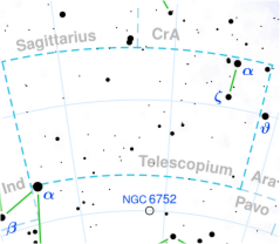Astronomy:HD 174474
| Observation data Epoch J2000.0 Equinox (celestial coordinates) | |
|---|---|
| Constellation | Telescopium |
| Right ascension | 18h 53m 02.34680s[1] |
| Declination | −48° 21′ 39.2965″[1] |
| Apparent magnitude (V) | 6.17±0.01[2] |
| Characteristics | |
| Spectral type | A2 V[3] |
| U−B color index | +0.08[4] |
| B−V color index | +0.14[4] |
| Astrometry | |
| Radial velocity (Rv) | −44±4[5] km/s |
| Proper motion (μ) | RA: −17.178[1] mas/yr Dec.: −77.772[1] mas/yr |
| Parallax (π) | 13.3771 ± 0.0444[1] mas |
| Distance | 243.8 ± 0.8 ly (74.8 ± 0.2 pc) |
| Absolute magnitude (MV) | +1.61[6] |
| Details | |
| Mass | 2.05±0.04[7] M☉ |
| Radius | 1.89±0.10[8] R☉ |
| Luminosity | 18.14[9] L☉ |
| Surface gravity (log g) | 4.21+0.09−0.06[10] cgs |
| Temperature | 8664±295[11] K |
| Metallicity [Fe/H] | −0.11[12] dex |
| Age | 630[11] Myr |
| Other designations | |
| Database references | |
| SIMBAD | data |
HD 174474, also designated as HR 7095 or rarely 35 G. Telescopii, is a solitary white-hued star located in the southern constellation Telescopium. It has an apparent magnitude of 6.17,[2] placing it near the limit for naked eye visibility. The object is located relatively close at a distance of 244 light years based on Gaia DR3 parallax measurements[1] but is drifting closer with a heliocentric radial velocity of −44 km/s.[5] At its current distance, HD 174474's brightness is diminished by 0.26 magnitudes due to interstellar dust.[14] It has an absolute magnitude of +1.61.[6]
This is an ordinary A-type main-sequence star with a stellar classification of A2 V.[3] It has double the mass of the Sun and 1.89 times the Sun's radius.[8] It radiates 18.1 times the luminosity of the Sun from its photosphere at an effective temperature of 8,664 K.[11] HD 174474 is slightly metal deficient with an iron abundance 22% below solar levels ([Fe/H] = −0.11). It is estimated to be 630 million years old based on stellar evolution models from David & Hillenbrand (2015).[11]
References
- ↑ Jump up to: 1.0 1.1 1.2 1.3 1.4 Vallenari, A. et al. (2022). "Gaia Data Release 3. Summary of the content and survey properties". Astronomy & Astrophysics. doi:10.1051/0004-6361/202243940 Gaia DR3 record for this source at VizieR.
- ↑ Jump up to: 2.0 2.1 Høg, E.; Fabricius, C.; Makarov, V. V.; Urban, S.; Corbin, T.; Wycoff, G.; Bastian, U.; Schwekendiek, P. et al. (March 2000). "The Tycho-2 catalogue of the 2.5 million brightest stars". Astronomy and Astrophysics 355: L27–L30. ISSN 0004-6361. Bibcode: 2000A&A...355L..27H.
- ↑ Jump up to: 3.0 3.1 Houk, Nancy (1978). Michigan catalogue of two-dimensional spectral types for the HD stars: Declinations −53° to −40°. 2. Bibcode: 1978mcts.book.....H.
- ↑ Jump up to: 4.0 4.1 Przybylski, A.; Kennedy, P. M. (1 December 1965). "Radial Velocities and Three-colour Photometry of 166 Southern Stars". Monthly Notices of the Royal Astronomical Society 131 (1): 95–104. doi:10.1093/mnras/131.1.95. ISSN 0035-8711. Bibcode: 1965MNRAS.131...95P.
- ↑ Jump up to: 5.0 5.1 Gontcharov, G. A. (November 2006). "Pulkovo Compilation of Radial Velocities for 35,495 Hipparcos stars in a common system". Astronomy Letters 32 (11): 759–771. doi:10.1134/S1063773706110065. ISSN 1063-7737. Bibcode: 2006AstL...32..759G.
- ↑ Jump up to: 6.0 6.1 Anderson, E.; Francis, Ch. (May 2012). "XHIP: An extended hipparcos compilation". Astronomy Letters 38 (5): 331–346. doi:10.1134/S1063773712050015. ISSN 1063-7737. Bibcode: 2012AstL...38..331A.
- ↑ Allende Prieto, C.; Lambert, D. L. (December 1999). "Fundamental parameters of nearby stars from the comparison with evolutionary calculations: masses, radii and effective temperatures". Astronomy and Astrophysics 352: 555–562. ISSN 0004-6361. Bibcode: 1999A&A...352..555A.
- ↑ Jump up to: 8.0 8.1 Kervella, P.; Thévenin, F.; Di Folco, E.; Ségransan, D. (October 2004). "The angular sizes of dwarf stars and subgiants". Astronomy & Astrophysics 426 (1): 297–307. doi:10.1051/0004-6361:20035930. ISSN 0004-6361. Bibcode: 2004A&A...426..297K.
- ↑ McDonald, I.; Zijlstra, A. A.; Boyer, M. L. (21 November 2012). "Fundamental parameters and infrared excesses of Hipparcos stars: Parameters and IR excesses from Hipparcos". Monthly Notices of the Royal Astronomical Society 427 (1): 343–357. doi:10.1111/j.1365-2966.2012.21873.x. ISSN 0035-8711. Bibcode: 2012MNRAS.427..343M.
- ↑ Stassun, Keivan G. et al. (9 September 2019). "The Revised TESS Input Catalog and Candidate Target List". The Astronomical Journal 158 (4): 138. doi:10.3847/1538-3881/ab3467. Bibcode: 2019AJ....158..138S.
- ↑ Jump up to: 11.0 11.1 11.2 11.3 David, Trevor J.; Hillenbrand, Lynne A. (12 May 2015). "The Ages of Early-type Stars: Strömgren Photometric Methods Calibrated, Validated, Tested, and Applied to Hosts and Prospective Hosts of Directly Imaged Exoplanets". The Astrophysical Journal 804 (2): 146. doi:10.1088/0004-637X/804/2/146. Bibcode: 2015ApJ...804..146D.
- ↑ Anders, F. et al. (August 2019). "Photo-astrometric distances, extinctions, and astrophysical parameters for Gaia DR2 stars brighter than G = 18". Astronomy & Astrophysics 628: A94. doi:10.1051/0004-6361/201935765. ISSN 0004-6361. Bibcode: 2019A&A...628A..94A.
- ↑ "HD 174474". SIMBAD. Centre de données astronomiques de Strasbourg. http://simbad.u-strasbg.fr/simbad/sim-basic?Ident=HD+174474.
- ↑ Gontcharov, George A.; Mosenkov, Aleksandr V. (28 September 2017). "Verifying reddening and extinction for Gaia DR1 TGAS main sequence stars". Monthly Notices of the Royal Astronomical Society 472 (4): 3805–3820. doi:10.1093/mnras/stx2219. ISSN 0035-8711. Bibcode: 2017MNRAS.472.3805G.
<ref> tag with name "Gould1879" defined in <references> is not used in prior text.
 |


